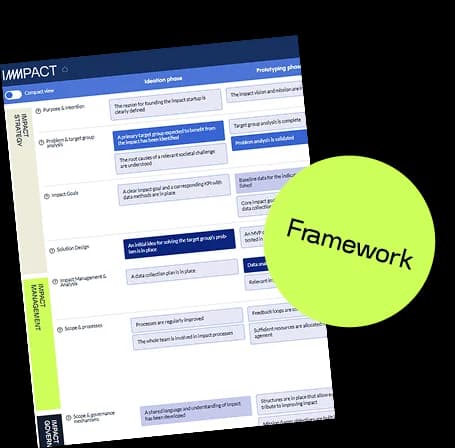AI-Generated Summary
Learn moreContext and Purpose
The "Immpact Framework" was created to assist impact entrepreneurs in navigating the challenges associated with establishing and managing businesses that aim to solve social and ecological problems. It was developed by SEND e.V. and PHINEO, organizations focused on social impact and sustainable development. The framework addresses the need for effective impact management (IMM) practices that are often hindered by a lack of financial, time, and technical resources.
Target Audience
The framework is primarily designed for three key groups: 1. Impact Entrepreneurs: Founders of impact start-ups who aim to address fundamental social and ecological issues through their business models. This includes both for-profit enterprises and non-profit organizations. 2. Impact Investors: Individuals or entities that provide venture capital to early-stage start-ups, particularly those new to the area of impact investing. 3. Ecosystem Representatives: Organizations and stakeholders, such as business consultants and policymakers, who support impact entrepreneurs and seek to create conducive regulatory environments.
The IMM Maturity Model
At the core of the framework is an IMM maturity model that serves as a guideline for impact practices and processes tailored to various developmental stages of impact start-ups. This model allows start-ups to assess their current position in their developmental journey, identify gaps, and gain insights into the expectations of impact investors. Investors, in turn, can use the model to understand what to expect from impact start-ups at different stages and provide targeted support.
Framework Basis
The maturity model draws from established frameworks such as the IMP Five Dimensions, IOOI logic, PHINEO’s impact staircase, and SDG Impact Standards. These frameworks were identified through surveys and analyses, highlighting their relevance and application in the field of impact measurement and management. The model categorizes IMM dimensions along a vertical axis and outlines traditional business development phases along a horizontal axis, indicating minimum standards and optional elements to accommodate varying knowledge levels and resource availability among entrepreneurs.
Future Developments
There are plans to develop the IMMPACT model into an online application that will be accessible to all users, integrating it with existing tools and resources to enhance its utility. The model is backed by a Sounding Board of IMM experts in Germany, who have provided initial feedback, ensuring that it meets the needs of its intended audience.
Broader Applicability
While the framework is tailored for impact entrepreneurs and investors, it also serves as a foundational resource for other sectors, such as the non-profit sector and public institutions, which may adapt it for their own models and initiatives. This versatility emphasizes the framework's potential to influence a wide range of stakeholders interested in sustainable development and social impact across Europe.
